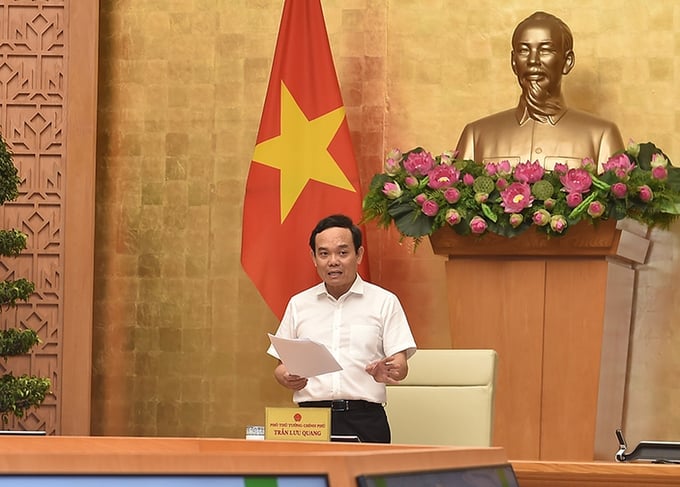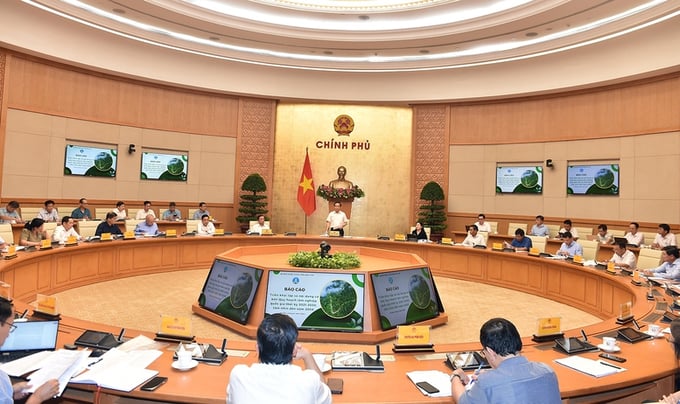November 28, 2025 | 03:46 GMT +7
November 28, 2025 | 03:46 GMT +7
Hotline: 0913.378.918
November 28, 2025 | 03:46 GMT +7
Hotline: 0913.378.918

Deputy Prime Minister Tran Luu Quang requested relevant parties to respond (if any) no later than Friday, June 21. Photo: VGP.
The National Forestry Planning was initiated in 2020 to address the issue of expanding forest area over time, while acknowledging the relatively low quality of forests, particularly natural forests. The Department of Forestry's statistics indicate that a significant proportion of woods, specifically 66.5%, are classified as poor, while 24.8% are categorized as average.
Moreover, the productivity of planted forests is insufficient, mainly providing small-sized timber, which fails to meet the requirements of the wood processing and export sectors. The technological prowess in many sectors of the economy is still at a low level, and the investment climate is filled with uncertainties. Instances of noncompliance with legislation pertaining to the protection and development of forests, such as illicit logging, encroachment, and uncontrolled exploitation of forest resources, continue to persist.
In order to tackle these concerns, the planning prioritizes enhancing the caliber of pre-existing natural forests. The projected average annual growth rate in the added value of forestry production is expected to range between 5 and 5.5%.
The strategy entails the annual planting of 238,000 hectares of production forests, 8,600 hectares of conservation and special-use forests, and the restoration of 22,500 hectares of natural forest. It is projected that by 2030, the total area of forest that will have obtained certification for sustainable management would surpass 1 million hectares.
The objective is to achieve an export value of $20 billion for wood products and forestry goods by 2025, and $25 billion by 2030. The projected domestic consumption of wood goods and forestry products is anticipated to increase to $5 billion by 2025 and further rise to $6 billion by 2030.
The predicted yearly growth rate for revenue from forest environmental services is 5%. The projected annual revenue from forest environmental services is anticipated to be 3,500 billion VND for the period of 2021-2025 and 4,000 billion VND for the period of 2026-2030.
In the period from 2021 to 2030, the combined area of national forests and forestry land is 15.848 million hectares. Special-use forests make up 15.5% of this area, protection forests account for 33%, and production forests cover 51.5%. The national forest coverage rate is projected to remain constant at a range of 42% to 43%.
During the discussion, the Minister of Agriculture and Rural Development voiced optimistic anticipation for the forthcoming National Forestry Planning. He is of the opinion that the planning will improve the potential and benefits of indirect values such as ecological variety, biodiversity, and genetic resources of forests.

The Ministry of Agriculture and Rural Development is expected to need more than 200,000 billion VND to implement the National Forestry Plan 2021-2030.
The Minister estimated that a total of 217,305 billion VND would be necessary for the implementation of the planned. Out of this amount, approximately 107,000 billion VND would be needed for the period of 2021-2025, which represents nearly 50% of the entire capital requirements.
Deputy Prime Minister Trần Lưu Quang concluded the meeting by instructing ministries, sectors, and localities to persist in examining the draft plans. All supplementary comments, if any, must be submitted to the Ministry of Agriculture and Rural Development by Friday, June 21st, in order to finalize the planning dossier.
The Deputy Prime Minister instructed the Ministry of Agriculture and Rural Development to thoroughly examine and verify the precise data regarding the extent of forest and forestry land in different regions. This includes accurately determining the area of each specific type of forest found on special-use forest land, protection forest land, production forest land, as well as forests on other types of land such as swidden land and hillside gardens.
The Government leader stressed the importance of minimizing modifications and eliminations of special-use and protection forest areas in the National Forestry Planning. Forests are a crucial asset for Vietnam, as they support the livelihoods of people and contribute to environmental protection and nature conservation.
In addition, he emphasized the necessity of conducting a comprehensive inventory of protection forests, special-use forests, and production forests in order to establish standardized input databases. These databases would serve as the basis for formulating policies that promote production and forestry development.
The Forestry Planning is a national sectoral plan for the period up to 2030, overseen and coordinated by the Ministry of Agriculture and Rural Development. It is one of four such plans. Other plans encompass the Planning for Disaster Prevention and Control and Irrigation, the Planning for Protection and Exploitation of Fishery Resources, and the Planning for the System of Fishing Ports and Storm Shelters for Fishing Vessels.
Translated by Linh Linh

(VAN) After the institutional merger, Da Nang possesses significant forest-carbon reserves and is proactively engaging in the carbon market, creating a new revenue stream.

(VAN) An Giang strengthens communication against IUU fishing, increases inspections and sanctions, and is determined to remove the EC’s “yellow card” while developing a sustainable fisheries sector.

(VAN) As green transition becomes a global trajectory, Viet Nam’s biggest challenge is not only technology and models, but how to ensure that capital flows reach the right beneficiaries.

(VAN) The Ministry of Agriculture and Environment must spearhead the construction of green governance, spanning decision-making processes and investment standards to policy evaluation mechanisms.

(VAN) The Agriculture and Environment sector of Khanh Hoa has achieved numerous milestones over the past 80 years, contributing significantly to the goal of establishing the province as a centrally governed city by 2030.

(VAN) Viet Nam is entering the pivotal period of 2025-2030, moving toward the formulation of the Remote Sensing Law, which will establish a legal foundation for the development of national digital data.

(VAN) The agricultural sector is finalizing the strategic framework for emission reduction, setting the goal of sharply cutting methane and 403.7 million tons of CO2 equivalent and moving toward Net Zero by 2050.